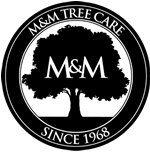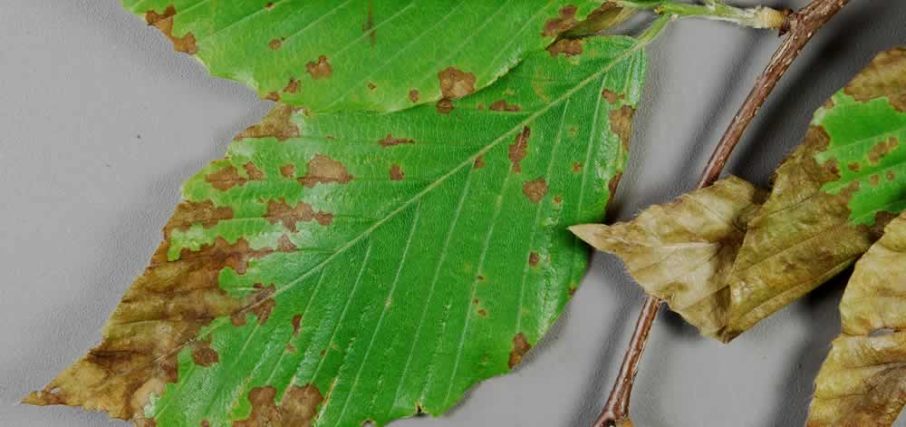What is Anthracnose?
Anthracnose is a fungal infection that creates spots, browning, and die-off in the foliage of trees and woody ornamentals in Wisconsin as well as throughout the US. Anthracnose actually means “ulcer-like sore,” and that is why it describes a family of fungal infections because it is based on the symptom rather than the specific fungus.
Don’t worry, Anthracnose has no relation to the similarly named anthrax and poses no harm to people. As mentioned, anthracnose is caused by several different fungi (generally in the Gloeosporium genus) and the fungi are tree (host) specific.
You will most commonly see anthracnose in trees like ash, maple, sycamore, walnut, and white oak. It normally just attacks young leaf tissue but can be more severe in sycamore where it sometimes extends to the ends of the twigs.
Will Anthracnose Kill My Tree?
In general, anthracnose will not kill a tree. Sycamore’s can be harder hit with anthracnose, and if it is a really bad infection, you can have enough damaged leaves to significantly harm your trees, but rarely does anthracnose kill a tree.
That said, you still want to take care of a tree with anthracnose because it compromises the tree’s overall health, and it could make it harder to fight against another infection if it is already struggling against anthracnose. The beauty of your tree is also compromised if it has anthracnose, and wouldn’t you rather enjoy looking at your trees? Treatment is simple, and we will cover treatment below.
How Can I Tell if My Tree Has Anthracnose?
Symptoms of anthracnose vary from tree to tree, but it generally shows up as irregular spots with dead areas on leaves that often follow the vein. The infected parts of the leaves generally turn tan or brown and leaves may curl and even fall off.
Yes, Anthracnose looks a lot like other common fungal infections, but the good news is, you don’t necessarily need to precisely know the exact fungus, because the treatment is generally the same for most fungal infections in trees. If it looks like anthracnose and the tree affected is one of the more susceptible trees to anthracnose, just treat it as if it is anthracnose unless you are seeing a significant problem with die-off or defoliation (then get help diagnosing the issue right away).
How Do I Treat for Anthracnose?
There are two protocols for taking care of anthracnose. Your first choice is to remove all dead foliage, especially dead leaves, from around the tree. Most trees pick-up anthracnose from infected, dead leaves…which should indicate why it is also important to rake up your leaves in the fall and spring. Keeping dead leaves away from trees is a great way to prevent infection in the first place.
The other plan of attack is to apply fungicide to the tree three times in the spring. It is important to apply in the spring because the fungus is most active in the cool, wet weather in spring and usually it does not fare well in the summer, but by then it already has a strong foothold in your leaves and it won’t disappear after infection set in. Here are the three times you want to apply fungicide for anthracnose:
- When the buds break
- When the leaves are about half expanded
- When the leaves are fully expanded.
You will want to make sure you alternate between at least two different active ingredients to help against fungicide-resistant anthracnose. In Wisconsin, fungicides with copper, chlorothalonil, or mancozeb are approved for use, but be sure to FOLLOW the DIRECTIONS carefully. If the application is too weak, you will not kill the fungus. If the application is too strong, you might kill some of the plants in the spray area.
For some trees, removing dead leaves every year is all you will want to do, especially if it is a very large tree that would be difficult to spray. For trees such as sycamore, you may need to do some pruning to remove infected twigs. We always like to recommend connecting with us about infected trees to get a free assessment of your trees since each situation can be different.
We will add, ensuring good tree health also allows the tree to fight anthracnose. Your tree might need fertilizer and you may need to evaluate if your tree needs a different watering plan than the one you currently have in place…too much water or too little water both can hurt a tree.
How Do I Dispose of Infected Tree Leaves?
Usually leaves can be burned or composted. While burying leaves away from your trees can solve your anthracnose problem, it can cause other problems if you don’t bury them deeply enough, such as encouraging the growth of diseases that move rapidly through the soil or create a nice nesting ground for ticks.
If you compost the leaves, you need to ensure your compost pile warms up to at least 140°F in order to kill the fungus. You will also need to ensure the pile is turned often enough so that all the leaves are “cooked,” otherwise the leaves toward the outside will not get warm enough. Make sure all the leaves are fully decomposed before applying your compost anywhere.
What is the Anthracnose Life Cycle?
Anthracnose usually hides in dead leaf litter, though in some cases, particularly in sycamore trees, it may also hide on the ends of twigs. In spring, spores spread by getting stirred up by wind and rain. The spores will germinate and attack young leaves as well as newly expanding twigs. It is possible for spores to be released and then infect other nearby leaves, especially in moist conditions.
In summer, the fungus pretty much stays put without making the tree worse nor will it infect new trees. When leaves fall in autumn, the wind-blown leaves can travel far and infect new trees. The fungi will overwinter in the dead leaves and the process begins again. While most people focus on leaf removal in autumn, be sure to remove leaves in early spring as well if new deposits of leaves formed when blown onto your property by the wind during the winter.
Anthracnose Key Points Review
- Anthracnose is fungal infection that usually causes tan or brown spots in leaves
- It is rarely lethal to your tree
- Keep dead leaves away from your trees
- Sometimes fungicide and pruning are appropriate for anthracnose
- Encouraging optimal health of your trees is always a good choice

